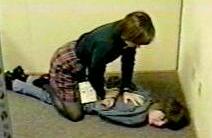


Chas' review of an article published in
The American Journal of Forensic Medicine and Pathology
September, 1998.
[19(3):201-205, 1998]

"We conclude that the hogtie restraint position by itself does not cause respiratory compromise to the point of asphyxiation and that other factors are responsible for the sudden deaths of individuals in this position.""... factors other than body positioning appear to be more important determinants for sudden, unexpected deaths in individuals in the hogtie custody restraint position."
I ALMOST CONCUR!
I agree that, Restraint - all by itself - is entirely unlikely to cause death. Chan et al. performed a sophisticated study of entirely healthy individuals placed in restraint (albeit not forceful-prone-restraint OR prone-hobble-restraint(1)), and alleged that these entirely healthy individuals experienced no "clinically significant" respiratory compromise from this bit of restraint.(2, 3) Whether or not one agrees with the "clinical significance" of their findings, I readily agree that there are "other factors" - apart from restraint - associated with Restraint Asphyxia deaths.
HOWEVER.
I am seriously concerned about the inference that Chan et al. make in their review of Restraint Asphyxia literature - the inference that "responsibility" for Restraint Asphyxia is attributable ONLY to "other factors" ... and that the "other factors" are "more important." That inference is entirely FALSE.(3)
Other studies of prone restraint have collected data that refute (and expose) Chan et al's continued efforts to minimize and understate the "clinical" effects of restraint. "Hobble restraint in the prone position leads to a dramatic impairment of hemodynamics and respiration."(3)
ADDITIONALLY, Chan et al. persist in failing to address two very important facts:
The "OTHER FACTORS" cited by the authors as being
"more important" factors in cases of Restraint-Related Positional Asphyxia
- BY THEMSELVES -
ALSO DO NOT CAUSE DEATH!
It is a COMBINATION of these factors, AND the application of forceful-prone-restraint (with or without hobble restraint), that causes Restraint Asphyxia deaths. And, application of forceful-prone-restraint is NOT an insignificant, or "less important," factor.
If individuals documented as dying from Restraint Asphyxia had NOT been restrained in a manner that interfered with their ability to breathe, it is entirely likely - to a high degree of medical certainty - that THEY WOULD NOT HAVE DIED!

 Developmentally Disabled Children are especially at risk for Restraint Asphyxia death. |
EMS and Fire Department emergency responders, often encounter extremely agitated and violent individuals. These individuals are extremely agitated and violent because they have an altered level of consciousness. The cause of their altered level of consciousness may be due to head trauma, psychiatric illness, developmental disabilities, diabetic hypoglycemia, drug and/or alcohol intoxication, a seizure disorder ... or the like. But, they ALL have an altered level of consciousness, for some "unhealthy" reason. Such extreme agitation and violent behavior is NOT NORMAL. |
To ensure the safety of these individuals, the safety of the public, and the safety of emergency responders, ALL extremely agitated and violent individuals REQUIRE RESTRAINT!
But, when forceful-prone-restraint or prone-hobble-restraint is applied to these individuals, they often DIE! Not from head trauma ... not from their seizure disorder or their diabetes ... not from drug or alcohol "overdose" - NOT from the "cause" of their altered level of consciousness.
They die because they are forcefully-prone-restrained, or prone-hobble-restrained.

Consider these facts:
Yet, the ONLY times that the deaths of these individuals are associated with the manner of their restraint, is when forceful-prone-restraint or prone-hobble-restraint is employed.
NONE.

IN SUMMARY:
Once again, Chan et al. have done an awful lot of work. But, their work offers NO NEW INSIGHT, no important new information, and absolutely NO ASSISTANCE for those of us whose livelihood requires us to safely deal with violent individuals in the field.
Additionally, within their 1998 Restraint Asphyxia literature review, Chan et al. had a wonderful opportunity to dispel the grossly erroneous misinterpretations that have been generated by their 1997 "restraint position" study's report (1). (Misinterpretations that they are well aware of.)
But, they did not do so.
Instead, they continue to erroneously infer that their 1997 clinical study (that of 15 entirely healthy individuals, minimally exercised and placed in comfortable restraint) has some kind of relationship with the field application of forceful-prone-restraint or prone-hobble-restraint to individuals with altered levels of consciousness.
It does not! And, I'm not the only person who recognizes this fact.(4, 5)
Thus, I DO NOT THANK THEM for their "effort."
Does anyone out there think that I SHOULD "THANK" Chan et al. for their "efforts?"
If so, plz Email your argument to me!
I maintain an open mind, and appreciate contributions from field personnel!!!
Ms. Charly D. Miller, Paramedic
EMS Author, Educator, Consultant

REFERENCES:


 Email Charly at: c-d-miller@neb.rr.com
Email Charly at: c-d-miller@neb.rr.com